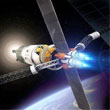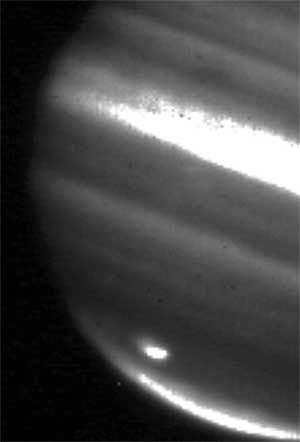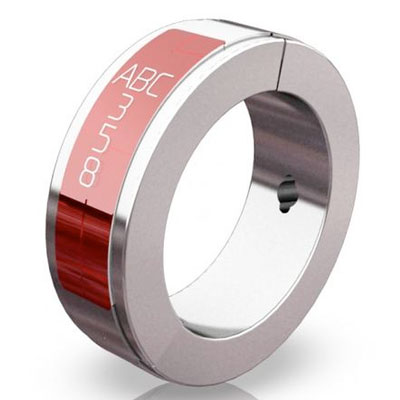 This week in TrekMovie’s Science Friday go to the Moon, Mars, and beyond with Lunar X-Prize and ion propulsion. For those of us still grounded here on Earth, you can take a look at a cometary impact into Jupiter. And, why don’t you glow in the dark while you’re at it? What, you didn’t know you could do that? Find out more in this week’s article, plus check out our gadget of the week: The Orb blutooth device.
This week in TrekMovie’s Science Friday go to the Moon, Mars, and beyond with Lunar X-Prize and ion propulsion. For those of us still grounded here on Earth, you can take a look at a cometary impact into Jupiter. And, why don’t you glow in the dark while you’re at it? What, you didn’t know you could do that? Find out more in this week’s article, plus check out our gadget of the week: The Orb blutooth device.
Lunar X-Prize Sending Piece of Apollo Back to the Moon
After man’s first walk on the moon in 1969, there was a massive push for of funding for research endeavors, scientific careers, and new technologies. Spin offs from technologies used in the space program were so foundational that, according to some authorities, every $1 invested in NASA by the government produces $7 or $8 in consumer products. Additionally, humans now know more about themselves and the universe than ever before. The 40th anniversary of the Apollo 11 mission has focused public discussion on why we haven’t sent a man to another planetary body since then, when predictions at the time stated that we would have had a man on mars a decade ago.
The Google Lunar X-Prize is looking to change all that and wants to speed-up our presence on the moon by introducing the private sector into the mix. They are offering a $30 million prize (put up by the sponsor Google) to teams that safely land a robot on the surface of the Moon, travel 500 meters over the lunar surface, and send images and data back to the Earth. To honor the Apollo missions, each team will send with their spacecraft a plaque in which eleven of the surviving Apollo astronauts have bestowed their names. The plaque will read:
“We Apollo Astronauts congratulate the winner of the Google Lunar X PRIZE. May this place, placed on the surface of the Moon by this intrepid craft and its team, serve as a welcoming beacon to future generations of lunar explorers. This spacecraft returns in the spirit of our journeys of the 20th Century – in peace and with hope for all humankind.”
- Col R. Walter Cunningham, USMCR, (Ret.), Apollo 7
- CAPT James A. Lovell, Jr., USN (Ret.), Apollo 8, Apollo 13
- BrigGen James A. McDivitt, USAF, Ret., Apollo 9
- Russell L. Schweickart, Apollo 9
- CAPT Eugene A. Cernan, USN (Ret.), Apollo 10, Apollo 17
- Dr. Buzz Aldrin, Apollo 11
- CAPT Alan L. Bean, USN (Ret.), Apollo 12
- CAPT Edgar D. Mitchell, USN (Ret.), Apollo 14
- LtCol Alfred M. Worden, USAF, Ret., Apollo 15
- BrigGen Charles M. Duke, Jr., USAF, Ret., Apollo 16
- Hon. Harrison H. Schmitt, Ph.D., Apollo 17
Jupiter Gets Big Impact
Something — probably a small comet — smacked into Jupiter on Sunday, leaving a bruise the size of the Pacific Ocean near its south pole. Just after midnight, Australian time, on Sunday, Jupiter came into view in the eyepiece of Anthony Wesley, the amateur astronomer that discovered the black spot near Jupiter’s south pole. Astronomers were scrambling to get big telescopes turned to Jupiter on Tuesday to observe the remains of what looks like the biggest smashup in the solar system since fragments of the Comet Shoemaker-Levy 9 crashed into the planet in July 1994. “This was a big event,” said Leigh Fletcher of the Jet Propulsion Laboratory. “In the inner solar system it would have been a disaster.” Now, with all that being said, there are some that have postulated that this was in fact caused by time traveling Romulans, and that whole “comet” story is just a bad cover-up.

The bright spot in the image is the impact. Photo courtesy of NASA.
Ion Engine Can Power 39-day Trip to Mars
Sending humans back to the moon is all well and good, but many are beginning to say, “been there, done that,” and are pushing to send men onto Mars. Critics point out that such trips would be long and grueling, taking about six months to reach the Red Planet. But now, researchers are testing a powerful new ion engine that could one day shorten the journey to just 39 days.
Traditional rockets burn chemical fuel to produce thrust. Most of that fuel is used up in the initial push off the Earth’s surface, so the rockets tend to coast most of the time they’re in space. Ion engines, on the other hand, accelerate electrically charged atoms, or ions, through an electric field, thereby pushing the spacecraft in the opposite direction. They provide much less thrust at a given moment than do chemical rockets, which means they can’t break free of the Earth’s gravity on their own. But once in space, they can give a continuous push for years, like a steady breeze at the back of a sailboat, accelerating gradually until they’re moving faster than chemical rockets.
The engine is being developed by the Ad Astra Rocket Company, which was founded in 2005 by plasma physicist and former space shuttle astronaut Franklin Chang-Diaz.
Don’t Look Now, but You’re Glowing. In the Dark. Yes, you!
Amazing pictures have been captured by Japanese scientists who have captured the first ever images of human bioluminescence. Although it has been known for many years that all living creatures produce a small amount of light as a result of chemical reactions within their cells, this is the first time light produced by humans has been captured on camera. The light is a thousand times weaker than the human eye can perceive. At such a low level, it is unlikely to serve any evolutionary purpose in humans – though when emitted more strongly by animals such as fireflies, glow-worms and deep-sea fish, it can be used to attract mates and for illumination. Maybe one day science can engineer a way to magnify this effect in humans making us SUPER GLOWING HUMANS! I’m not sure what advantage that would posses, but it’d be FREAKING SWEET!

Like I said, FREAKING SWEET!
Gadget of the Week: COOLEST BLUTOOTH HEADSET EVAR!
Yes, the coolest blutooth headset in the world (notice ALL CAPS headline), the Orb, is a sweet looking earpiece that transforms into a ring with a flexible organic LED (FOLED) data display that shows you caller ID, calendar items, and voice to text info. If you want to take a call, simply take the ring off your finger, and twist it into its headset shape. This is such a forward design, we were thinking it was a mere concept, but no — it’ll go on sale in January, with the base model selling for $129, and the Deluxe Edition (the one with that FOLED display) following in April for $175. Now if they could just make that little ring vibrate when a phone call comes in, it would be the ideal blutooth headset.

The headset showing both modes

A close-up of the FOLED ring
#FollowFriday
If you are on Twitter, you know there are plenty of amazing people out there tweeting away. And, many of them are scientists! Every Friday I’ll be bringing you a new list of great scientists, techies, and geeks to follow on Twitter. This week…
- @NathanFillion: Capt. Reynolds, star of Firefly. Recent tweet: “Things that scare me: Sharks. Bears. Zombies. Crowds. Zombie crowds. Closed spaces. Children singing.”
- @LCROSS_NASA: NASA mission to explore the Moon and see if there is water ice near one of the lunar poles! Recent tweet: "”It’s been a long road, To get from there to here.” Mission Day 34. 78 days more cruisin’ ahead. Have traveled over 2,538,000km in space.”
- @roddenberry: Rod Roddenberry. Recent tweet: “This is what real life exploration is about! Talk about alien life form… Don’t need to go to another planet to find… It’s right here!”
Science Quickies
Not enough science for you? Here’s a warp-speed look at some more science tid-bits that are worth a look.
- Eye of cosmic “storm” blazes with black hole, Spitzer Space Telescope has new awesome images!
- Giant toucan bills help birds keep their cool
- New NASA administrator optimistic about reviews
TrekMovie’s Science Friday is an homage the the great NPR radio show Science Friday. Science Friday® is a registered service mark of ScienceFriday Inc.

It’s not an ion engine, it’s a plasma engine.
wow. Thats incredible ! I really like the Ion Engine. Hopefully this fuels some more vision and excitement into a possible mission to mars. 39 days to Mars is incredible ! Instead of many many months… it would instead take just 1 month to get to the small red planet ! Hopefully the Obama administration fund this future mission to mars. I would not sleep all night, in hopes to watch progress reports of the mission on tv ! These space missions can unite the world in a cause of exploration. Hopefully this gets pushed forward.
@tooboldlygo:
Thank you. I was going to post the same thing. Ad Astra’s Plasma engine can produce more thrust than an ion engine, like DS1, etc.
Announcing the KAYLA IACOVINO (prounced Ya-co-Vee-no) International Fan Club.
Hey, she’s gorgeous, she’s sexy, she’s early Twenty-something, she’s brilliant, she’s a frakking Scientist for Spock’s sake, she’s a Marta Britanites (TNG: Tapestry) look-a-like, she’s a college girl, she’s funny, she’s approachable, AND she’s a TREKKIE!!!!!! What more do you want???
Funny hats are required. Bring your own jug of wine, I’ve found mine.
}:-D>
In high school my physics teacher answered my question of whats the difference between plasma and ion.
Mr. Millers answer was plasma was a free radical atoms in a steady state like what the sun is made of, And a ION is free radical atoms with velocity traveling a distance in a strait line.
I do not know if that is how a dictionary defines them but thats how I recall it. If I am wrong please correct this and with information to your backup validating proof, i.e. the hyperlink.
Views are nice but proof is perfect so we get things correct and true.
And the 39 day trip to Mars is like a long ocean liner cruise. I hope one day the prices will become similar. But my guess is it will be after I’m gone, and I’m 49 so I got another 50 years or so.
The bluetooth looks cool… but I can see it falling off people’s ears all teh time and people losing them.
I always get the I confused with a lower case L In her name. I don’t know why. Thanks for the pronunciation help Commodore. Great article Kayla! Looks like you might get a Trekkie fanbase soon.
5: An ion is simply an electrically charged atom, i.e. an atom which lacks some electrons in its shell or an atom with a surplus of electrons.
Sometimes, any charged particle is called an ion.
It has nothing to do with the motion of the particle. If ions move on a straight line, then you have ion radiation.
A plasma is a gas consisting of ions and free electrons.
Reference: Myself. I have a degree in physics.
What toboldlygo said.
The engine is called VASIMIR. It isn’t an ion engine, it is capable of enormously greater thrust levels. Google it.
The VASIMR engine is a terrific concept, but it’s going to require a huge honking power supply as currently envisioned. But give ’em time; I suspect they’ll work it out.
Nice round-up, Kayla.
What the heck kind of accent does that New Scientist narrator have on the plasma engine video above? I mean, besides robotic.
Plasma engines to Mars!
Scott B. out.
Good thing those comets crashed into the solar system’s third-world slums and not here on Earth where it would matter and make real news.
11. Rick… Yep, it will need a nuclear reactor. That’s not a can of worms I’d want anything to do with.
13. Frederick… No kidding! That impact scar on Jupiter is wider than the Earth itself!
One day the Starship Enterprise will become reality with Ion propulsion.
#15
Ah, yes i hope one day it will….i may not know much but i do know that the human race will explore space the way Star Trek did…
As a matter of fact im waiting around for the First Contact on April 20th 2063 (correct me if i’m wrong) yes, im one of those foolish kids but hey i’ve got nothing to lose and besides i’ll besides i’ll be 68 nearly 69 when that day comes!
Remember how Gene Roddenberry’s vision stunned the world? But it was a little too early and it just started to capture the minds of people in the late 70’s? Well i think his prediction of the First Contact might be a little too early as well…i’d say give them 100 more years…
Thanks Kayla! Sign me up for that fan club too!
I’ll definitely be hooking up with one of those bluetooth rings! Functional and stylish at the same time! I likey!
My physics teacher also had a degree in physics, but you have to remember we were only high school students and he had to word things so even the stonys could comprehend things. Mr Miller also said if you need to know more you have a school library card. But he said that with most questions asked.
And he intern learned from me and my brother as we played with making Holograms. He would have liked playing with the Lasers I helped others do laser light shows with for Hard to Heavy Metal Rock bands in the 80’s. But the Air Force did not like our 1987 Sturgis light shows as it interfered with their B-1 Bomber runs over Canada.
I’m glad someone is playing with rockets that do not use frozen tanks of fuel. and have a more that single digit trust/weight ratio. And our Astronauts may look better that a few Ants taped onto the nose cone of a bottle rocket.
So when will they make a cell phone that looks like a TOS Communicator, or a Comm badge that blue thooth’s to your phone on your belt.
All good stuff.
Except maybe the cosmic splashdown on Jupiter. No bueno.
18: No doubt Mr Miller knows his physics. Maybe you just got ion radiation mixed up with ions after all those years :-)
Nathan Fillion needs to be more careful about listing his fears. Joss Whedon might just cast him as a man in a bear cage suspended over a shark tank surrounded by a crowd of singing zombie children.
21:
Lol, that’ funny, and plausable. }:-D>